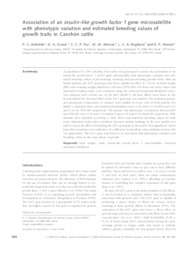Association of an insulin-like growth factor 1 gene microsatelit with phenotypic variation and estimated breeding values of growth traits in Canchim cattle.
Association of an insulin-like growth factor 1 gene microsatelit with phenotypic variation and estimated breeding values of growth traits in Canchim cattle.
Author(s): ANDRADE, P. C.; GROSSI, D. A.; PAZ, C. C. P.; ALENCAR, M. M. de; REGITANO, L. C. de A.; MUNARI, D. P.
Summary: A population of 1398 Canchim (CA) cattle was genotyped to asses the association of na insulin-like growth factor 1 (IGF1) gene microsatellite with phenotypic variation and estimated breeding values of pre-weaning, weaning and post-weaning growth traits. After na initial analysis, the IGF1 genotype only had a significant effect (P < 0.05) on birth weight (BW) and weaning weight adjusted lo 240 days (WW240). For these two traits, direct and maternal breeding values were estimated using the restricted maximum likelihood (REML). Two analyses were carried out. In the first (Model I), all fixed effcts were fitted. In the second (Model II). The fixed effect of the IGF1 genotype was omitted. The estimated genetic and phenotypic components of variance were similar for every trait in both models. For Model I estimated direct and maternal herilabilities were 0.26 and 0.16 for BW and 0.23 and 0.14 for WW240 respectively. The genetic and phenotypic correlations between BW and WW240 were 0.38 and 0.38 (Model I) and 0.19 and 0.38 (Model II) respectively. Fifty animais were classified according to their direct and maternal breeding values for both traits. Spearman rank-order correlation between animal rankings in the two models was used 10 asses the effect of including the IGF1 genotype in the model. Non-significant values from this correlation were indicative of a difference in breeding value rankings between the two approaches. The IGF1 gene was found to be associated with phenotypic variation and breeding values in the early of growth.
Publication year: 2008
Types of publication: Journal article
Keywords: Body weigth, Bovino, Gado de Corte, Insulin like, Maximum likelihood, Microsatellite
Observation
Some of Embrapa's publications are published as ePub files. To read them, use or download one of the following free software options to your computer or mobile device. Android: Google Play Books; IOS: iBooks; Windows and Linux: Calibre.
Access other publications
Access the Agricultural Research Database (BDPA) to consult Embrapa's full library collection and records.
Visit Embrapa Bookstore to purchase books and other publications sold by Embrapa.

